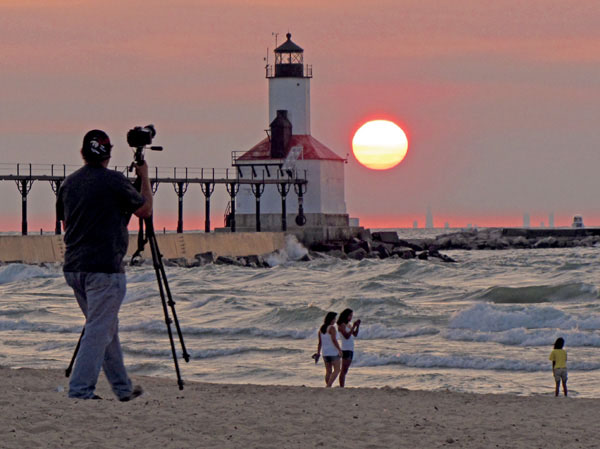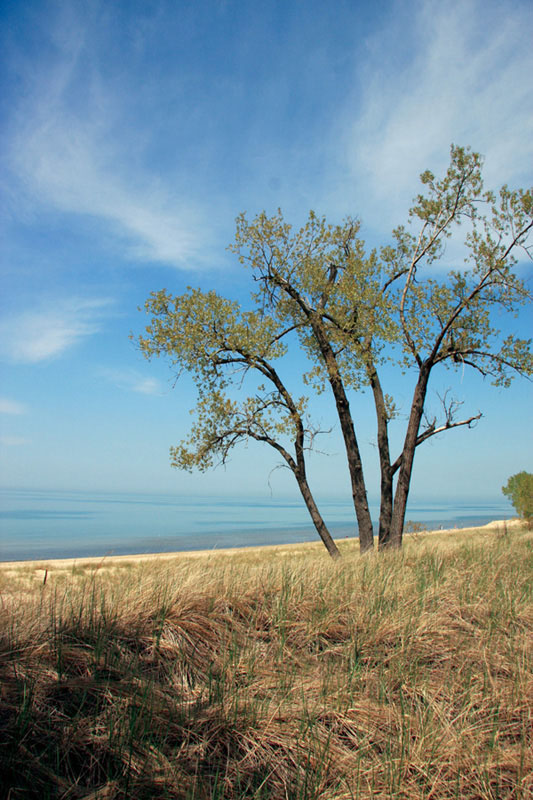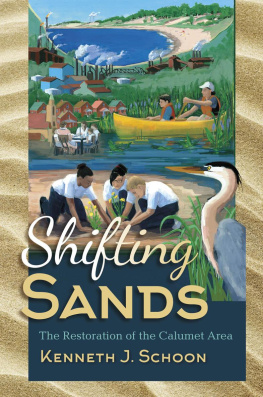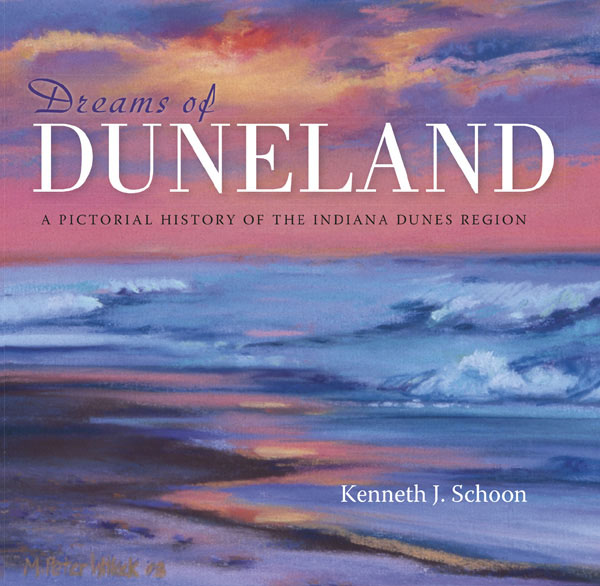ACKNOWLEDGMENTS
T he author offers his sincere thanks to the following people who assisted with the writing of this book:
For suggesting that I begin this project, Susan MiHalo.
For finding facts, figures, and photos, IU Northwest Archivist Steve McShane; IU Northwest Instructional Media personnel Daniel Ichinose, Karen Newlin, Paul Sharpe, and Tome Trajkovski; librarians, curators, and researchers Larry Clark, David Hess, Eva Hopkins, David Kiehn, Carl O. Reed, Laura Shields, and Jane Walsh Brown; Anne Koehler, national and state park personnel Edwin Alcox, Brandt Baughman, Brad Bumgardner, Judy Collins, Christine Gerlach, Tricia Hodge, Marcus Key, Daniel Mason, Ruthanne Slamka, Wendy Smith, Kim Swift, and Superintendent Costa Dillon; industry representatives Erin DiPietro, Liz Folkerts, Nick Meyer, and Katie Patterson; graphic artist Jim Fields; also, Marilyn Arvidson, Peter Avis, Bruce Ayers, Nicole Kamins Barker and the staff at Save the Dunes, Nancy Jahnel Barnes, Lee Botts, Brian Breidert, Ken Brock, Jean Graham Buckley, Paul L. Childress, Spencer Cortwright, Erin Crofton, Bryan Dayson, Joyce Ebert Davis, Nancy Douglass, Janet Edwards, Dale Engquist, Clara Harmening, John Hayes, the late Ed Hedstrom, Gregg Hertzlieb, Steve Hornyak, Pamela James, Lewis Jones, Barbara Keinbaum, Matt Keiser, Zoran Kilibarda, Michael Kobe, Kris Krouse and the staff at Shirley Heinze Land Trust, Dani Lane, Ken Larson, Patrick Leacock, Johnny Martinez, Dick Meister, Susan MiHalo, Jason Miller, Mike Molnar, Zella Olson, Francis H. Parker, Noel Pavlovic, Trent Pendley, Raquel Perez, Jerry Peters, Marti Pizzini, Dan Plath, Chief Boatswains Mate Rebecca Polzin, Jude Rakowski, Herb and Charlotte Read, Mark Reshkin, Janice Rice, Steve Spicer, Mark Stanek, Michael Swygert, Todd Thompson, Lake County Surveyor George Van Til and supervisor Susan Harmening, Bill Warrick, the staff at Fort Ligonier, Bill Wild, Sandi Weindling, and Peter Youngman.

Photographer Jim Rettker catches another photographer about to catch a beautiful Michigan City sunset. Jim Rettker
For allowing me to use their wonderful photographs and artwork: Diana Birky, Kermit Clyne, Peter Dougherty, Tom Dogan, Jim Fields, Michael Gant, Tony Gaul, M. A. Griswold, Lee Hibbs, Indiana Department of Natural Resources, Indiana Historical Society, Kira Kaufmann, Michael Kobe, David A. Larson, Rich Manalis, Christopher A. Meyers, Carol Moore, National Park service staff and volunteers, Zella Olson, Bj Parmley, Dan Plath, James Rettker, Jim Sprandel, Kim Swift, Ron Trigg, Bill Warrick, Gordon Wilder, Elaine Wojcinski, Carol Wood, Fredric Young, the Bauer Museum of Art, and Marikay Peter Witlock, for her superb paintings of the dunes and lakeshore.
For reviewing parts of the manuscript and making invaluable suggestions: Marilyn Arvidson, Brandt Baughman, Lee Botts, Brad Bumgardner, Costa Dillon, Dale Engquist, Jackie Glidden, Pamela James, Dani Lane, Jerry Peters, Carl O. Reed, Janice Rice, Steve Spicer, and Michael Swygert.
For finding books, articles, and miscellaneous information, for accompanying me on research trips, for copy editing, and for compiling the index, Peg Schoon.
The author and IU Press also thank Indiana University Northwest Academic Affairs, the Legacy Foundation, Friends of Indiana Dunes, and Save the Dunes for funds that allowed for the larger page size and the inclusion of so many color photographs.

Beachfront Trees. Cottonwood trees are very adaptable to the shifting sands of the Indiana Dunes. (left) Pete Doherty, Doherty Images
Driftwood, Indiana Dunes National Lakeshore, Lake Michigan. (overleaf) Steve Geer
A foursome going down for a swim. (overleaf) Ron Trigg
APPENDIX A
Duneland Misconceptions and Urban Legends
Misconception: Glaciers made the sand dunes.
Although the glaciers did grind lots of rock into sand, the dunes were made by the wind blowing the sand away from the lake.
Misconception: Lake Chicago was an arm of the sea.
The name Lake Chicago has always been confusing.
What geologists used to call Lake Chicago was a freshwater lake formed when the glaciers receded.
Misconception: Lake Chicago was a different lake than Lake Michigan.
Lake Chicago was always the same lake as Lake Michigan. The different name was used to denote its earlier stages when the lake drained through the Illinois and Mississippi Rivers. To reduce the confusion, the old term has been replaced by Glacial Lake Michigan.
Misconception: Mount Baldy is the tallest dune along the Lake Michigan shoreline in Indiana.
Mount Tom is the tallest. Mount Baldys fame is that its a wandering, or moving, dune.
Misconception: Claude Allouez and Claude Dablon were the first European explorers in the Calumet Area.
There is no evidence that any European explorers were in Illinois before Marquette and Jolliet in 1673 and no evidence that any were in Indiana before Marquette in 1675.
Misconception: Bailly was not really the first European settler.
Some tombstones from the early 1800s have been weathered so badly that is nearly impossible to know if their death dates precede Baillys arrival. They may date from the 1810s or the 1840s. Careful reexamination was inconclusive. There are no other records that imply settlement before 1822.
Misconception: Anders Chellberg helped start the Augsburg Lutheran Church.
The Augsburg church in Porter was established in 1858, five years before the Chellbergs arrival.
Misconception: Chanute was the first man to fly a glider.
Octave Chanute apparently never did fly himself. He did publish the first scientific review of aviation experiments, he did (at the Dunes) conduct the first scientific experiments of various gliders, he did design the first reasonably-stable flying machine, and he did visit and advise the Wright Brothers.
Misconception: Alice Gray (Diana of the Dunes) was the daughter of a prominent physician.
Her father was Ambrose Gray, a Chicago laborer who didnt have much money.
Misconception: Miller was named for a man named John.
Miller (actually Miller Station) was named for Samuel Miller, who had a son named John.
Misconception: NIPSCOs Michigan City Generating Station is nuclear-powered.
The Michigan City Generating Station is coal-powered.
It does have a cooling tower similar to the ones used elsewhere at nuclear-powered plants.
Misconception: Fish caught in Lake Michigan shouldnt be eaten by people.
The state of Indiana publishes guidelines on how much fish one should eat. Too much may be unhealthy.
APPENDIX B
Indiana Dunes National Lakeshore Statistics
The National Lakeshore today has fifteen miles of lake Michigan shoreline and 15,177 acres of land (including the 2,182 within Dunes State Park). Parklands are located in Lake, Porter, and LaPorte Counties and in fifteen cities and towns.








